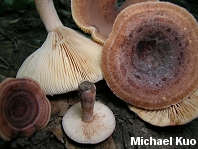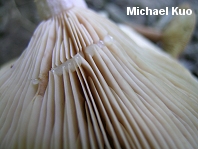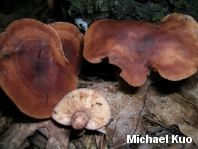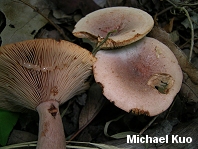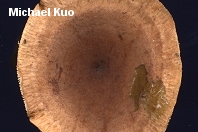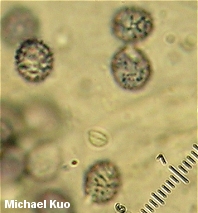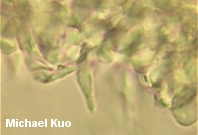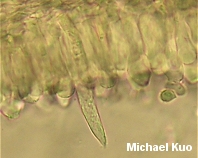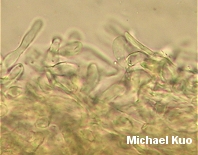| Major Groups > Gilled Mushrooms > Pale-Spored > Lactarius > Lactarius quietus var. incanus |

|
Lactarius quietus var. incanus [ Agaricomycetes > Russulales > Russulaceae > Lactarius . . . ] by Michael Kuo A combination of features defines this oak-loving, eastern Lactarius. Its milk is thick and white when the mushroom is young, but soon becomes more like skim milk, and by maturity is almost watery. The cap is often zoned with beautiful shades of dark reddish brown, but the zones may be faint, or may resolve by maturity, leaving the cap evenly colored. When young there is a whitish dusting on the cap. The stem darkens from the base upward as the mushroom matures. The odor is fragrant, and the taste is mild or slightly acrid. Since there are a number of frustratingly similar species (including the appropriately named Lactarius frustratus), microscopic features should probably be checked, as well; unlike most of its look-alikes, Lactarius quietus var. incanus has a non-gelatinized, trichodermal pileipellis. Description: Ecology: Mycorrhizal with oaks, and perhaps with other hardwoods in oak-based forests; growing alone, scattered, or gregariously; summer and fall; widely distributed in eastern North America. Cap: 3-11 cm; convex, becoming flat or shallowly vase-shaped; dry; smooth or uneven and somewhat rugged; when young often with a whitish dusting; usually zoned with shades of dark reddish brown, but sometimes becoming vaguely zoned or without zones--or becoming less zoned with age. Gills: Attached to the stem or running slightly down it; close or nearly crowded; whitish at first, developing cinnamon stains and discolorations, but not staining from the milk. Stem: 4-14 cm long; up to 1.5 cm thick; more or less equal; smooth; without potholes; when young with a white dusting; colored like the cap, but paler; darkening with age from the base upward; hollowing. Flesh: Whitish to pinkish; not changing when sliced, or staining slowly pinkish. Milk: White at first, becoming watery with age; sometimes slightly yellowish; not changing on exposure; not staining tissues; often staining white paper yellow overnight. Odor and Taste: Odor strongly fragrant, or not distinctive; taste mild or slightly acrid. Chemical Reactions: KOH olive on cap surface. Spore Print: White or pale yellowish. Microscopic Features: Spores 6-8 x 5-7 µ; broadly ellipsoid; ornamentation 0.5-1.0 µ high, as amyloid warts and scattered ridges that occasionally form zebroid patterns but do not form reticula. Pleuromacrocystidia scattered to abundant; fusoid; to about 70 x 10 µ. Cheilocystidia scattered to abundant; fusoid; to about 40 µ long. Pileipellis a trichoderm or oedotrichoderm. REFERENCES: Hesler & Smith, 1979. (Roody, 2003; McNeil, 2006; Binion et al., 2008.) Herb. Kuo 07140313, 07220313, 10020301, 07160402, 08010403, 07090705, 07130808. This site contains no information about the edibility or toxicity of mushrooms. |
© MushroomExpert.Com |
|
Cite this page as: Kuo, M. (2011, March). Lactarius quietus var. incanus Retrieved from the MushroomExpert.Com Web site: http://www.mushroomexpert.com/lactarius_quietus_incanus.html |
